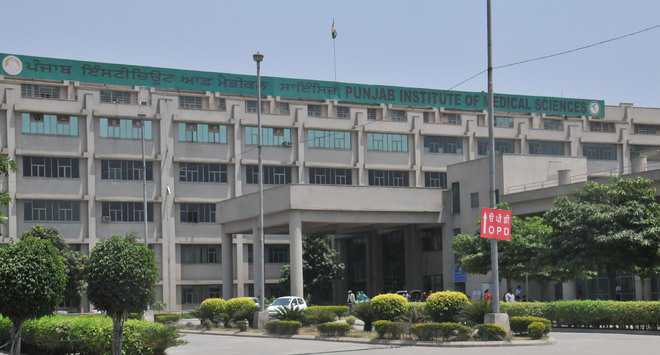
The Punjab Institute of Medical Sciences, Jalandhar, has been facing a crisis since long. Tribune file photo
Vishav Bharti
Tribune News Service
Chandigarh, July 24
Punjab couldn’t open any government medical college in the past 65 years, but it facilitated the opening of five private medical institutes in the past decade. The result is for all to see: of the five colleges, one has been shut down, another has been debarred from admitting students and a third is struggling for survival. And when it comes to the MBBS fee, it has witnessed a 20-fold increase in 10 years.
The private sector in medical education witnessed a boom, especially in the past decade. At present, 10 medical colleges in the state offer 1,445 MBBS seats — about 250 seats are no more up for grabs — and 70 per cent of the total seats are in seven private colleges.
Till a decade ago, the government-private ratio of MBBS seats in the state’s medical colleges was 60:40. Dayanand Medical College and Hospital (DMCH) and Christian Medical College (CMC) in Ludhiana, and Sri Guru Ram Das Medical College (SGRD) in Amritsar are run by private trusts and these have existed for long. But in the past 10 years, four medical colleges were opened — Chintpurni Medical College and Hospital, Pathankot; Adesh Institute of Medical Sciences and Research, Bathinda; Gian Sagar Medical College and Hospital, Banur; and Punjab Institute of Medical Sciences (PIMS), Jalandhar.
“These colleges are guilty of introducing the idea among medical aspirants that money can get them admission in a college,” says Dr Pyare Lal Garg, former Registrar, Baba Farid University of Health Sciences (BFUHS), Faridkot.
As for the standard of education in private colleges, their performance is dismal. The Chintpurni college has been debarred from admitting students and Gian Sagar college has been shut down, while two others have converted themselves into deemed universities to dodge the MCI and state government regulations. And the PIMS is facing a serious crisis.
The emphasis of college managements has been to turn the institutes into private universities, so that they can go out of regulatory mechanism of the state government and the Medical Council of India (MCI).
But when it comes to the government updating its medical education infrastructure, the state draws a blank. The last government medical college opened from scratch was 65 years ago. It was Government Medical College, Patiala, established in 1951.
Guru Gobind Singh Medical College, Faridkot, was the latest edition, but it was not conceived by the state. It was being run by a trust in Patna (Bihar) before the state brought the college under its ambit in 1978.
Amid the decline of the government sector in medical education and the ‘rise’ of the private sector, students paid a heavy cost. Till 2003, the five-year course fee for a government quota MBBS seat was just Rs69,000. Now, it is more than Rs13 lakh — a 19-fold increase.
Dr Raj Bahadur, Vice-Chancellor, BFUHS, says the only way out of this situation is massive government investment in medical and dental education. “The health of the state depends on the quality of doctors it produces. And the quality depends upon the nursery — medical colleges — from where they are being produced. Therefore, it is imperative that a special consideration should be given in the Budget for health and medical education,” he said.
State of dental education even worse
The scenario in dental education is worse than the MBBS education. In past decade, about 10 private dental colleges were opened in the state, taking the number to 11. These colleges offer 1,050 seats. For the past several years, around 40 per cent of the seats have been remaining vacant in spite of having eligible candidates.



























